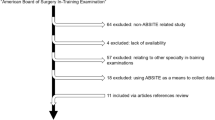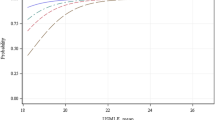Abstract
Introduction
The purpose of this research was to determine what, if any, relationship existed between in-training exams (ITE) given during the categorical years of anesthesiology residency training and first attempt performance on Part One of the American Board of Anesthesiology (ABA) certification examination (CE). Additionally, several variables available to residency program directors, to include gender, medical degree, medical school, and United States Medical Licensing Examination (USMLE) Step 1 and Step 2 CK scores, were analyzed to determine if a predictive relationship existed between any variable(s) and the Part One CE. Current research in anesthesiology only looked at PGY-II ITE scores, while other specialties have found relationships in later years of training not yet studied in anesthesiology.
Methods
The authors studied data from one US anesthesiology residency program. In total, there was data from the residency files of 79 residents. First attempt ABA CE results were coded as a binary dependent variable, either pass or fail. ITE scores at all three categorical years of training, as well as other available variables, were used to see if any predictive relationship exists.
Results
The PGY-IV ITE was found to be the only year of ITE that was statistically significant in predicting eventual first attempt performance on the ABA Part One CE. Logistic regression, utilizing the backward elimination technique, returned a model utilizing three variables: PGY-IV ITE, gender, and USMLE Step 2 CK scores. This model correctly predicted 89.9 % of eventual performance.
Discussion
The major finding in this study is that higher ABA/ASA ITE scores taken at the end of the final year of anesthesiology residency served as a statistically significant predictor of first attempt performance on the ABA Part One CE. Future studies should be performed at a national level to identify whether this finding is applicable to a wider population.
Similar content being viewed by others
Abbreviations
- ABA:
-
American Board of Anesthesiology
- ACGME:
-
Accreditation Council for Graduate Medical Education
- CE:
-
Certification examination
- CMS:
-
Centers for Medicare and Medicaid Services
- ERAS:
-
Electronic Residency Application Service
- GME:
-
Graduate Medical Education
- IRB:
-
Institutional review board
- ITE:
-
In-training examination
- PGY:
-
Post-graduate year
- RRC:
-
Residency Review Committee
- UMMC:
-
University of Mississippi Medical Center
- USMLE:
-
United States Medical Licensing Examination
References
ACGME (2012) ACGME Fact Sheet. Retrieved November 7, 2012, from http://www.acgme.org/acgmeweb/Portals/0/PDFs/Fact_Sheet.pdf
Tetzlaff JE (2009) Assessment of competence in anesthesiology. Curr Opin Anaesthesiol 22(6):809–813. doi:10.1097/ACO.0b013e3283326958
Wasnick JD, Chang L, Russell C, Gadsden J (2010) Do residency applicants know what the ACGME core competencies are? One program’s experience. Acad Med 85(5):791–793. doi:10.1097/ACM.0b013e3181d71d7b
Replogle WH (2001) Interpretation of the American Board of Family Practice in-training examination. Fam Med 33(2):98–103
ASAHQ (2013) Educational opportunities. Retrieved February 19, 2013, from http://www.asahq.org/For-Members/Education-and-Events.aspx
ACGME (2012) Anesthesiology Program Requirements. Retrieved September 22, 2012, from http://www.acgme.org/acWebsite/RRC_040/040_prIndex.asp
Shellito JL, Osland JS, Helmer SD, Chang FC (2010) American Board of Surgery examinations: can we identify surgery residency applicants and residents who will pass the examinations on the first attempt? Am J Surg 199(2):216–222. doi:10.1016/j.amjsurg.2009.03.006
McClintock JC, Gravlee GP (2010) Predicting success on the certification examinations of the American Board of Anesthesiology. Anesthesiology 112(1):212–219. doi:10.1097/ALN.0b013e3181c62e2f
Althouse LA, McGuinness GA (2008) The in-training examination: an analysis of its predictive value on performance on the general pediatrics certification examination. J Pediatr 153(3):425–428. doi:10.1016/j.jpeds.2008.03.012
Glass DD (1995) Time-limited certification. American Board of Anesthesiology. Anesthesiology 83(2):413–415
Slogoff S, Hughes FP, Hug CC, Longnecker DE, Saidman LJ (1994) A demonstration of validity for certification by the American Board of Anesthesiology. Acad Med 69(9):740–746
Makdisi G, Takeuchi T, Rodriguez J, Rucinski J, Wise L (2011) How we select our residents—a survey of selection criteria in general surgery residents. J Surg Educ 68(1):67–72. doi:10.1016/j.jsurg.2010.10.003
Nallasamy S, Uhler T, Nallasamy N, Tapino PJ, Volpe NJ (2010) Ophthalmology resident selection: current trends in selection criteria and improving the process. Ophthalmology 117(5):1041–1047. doi:10.1016/j.ophtha.2009.07.034
IRB (2012) Policy and Procedure Manual. Retrieved November 7, 2012, from http://irb.umc.edu/newdoc/P&P%2005%20v3.1.pdf
Bewick V, Cheek L, Ball J (2005) Statistics review 14: logistic regression. Crit Care 9(1):112–118. doi:10.1186/cc3045
Concato J, Feinstein AR, Holford TR (1993) The risk of determining risk with multivariable models. Ann Intern Med 118(3):201–210
Hosmer DW, Lemeshow S (2000) Applied logistic regression (2 ed.): John Wiley & Sons, Inc
Laupacis A, Sekar N, Stiell IG (1997) Clinical prediction rules. A review and suggested modifications of methodological standards. JAMA 277(6):488–494
Steyerberg EW, Eijkemans MJ, Harrell FE, Habbema JD (2000) Prognostic modelling with logistic regression analysis: a comparison of selection and estimation methods in small data sets. Stat Med 19(8):1059–1079
Author information
Authors and Affiliations
Corresponding author
Rights and permissions
About this article
Cite this article
Schmitz, T.W., Bailey, J.H. Determining Predictors of Success on the American Board of Anesthesiology Written Certification Exam. Med.Sci.Educ. 24, 195–200 (2014). https://doi.org/10.1007/s40670-014-0044-z
Published:
Issue Date:
DOI: https://doi.org/10.1007/s40670-014-0044-z




